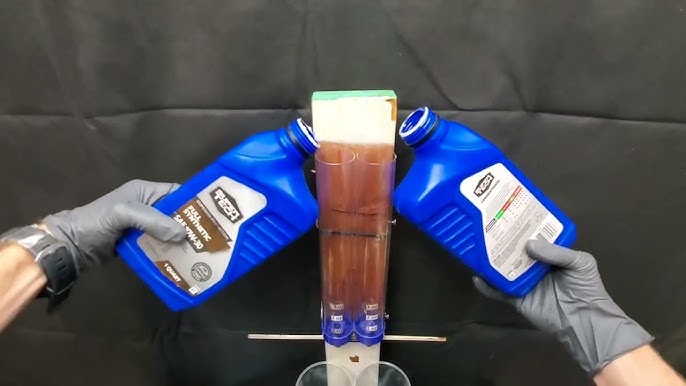No, you should not mix synthetic brake fluid with regular brake fluid. Mixing them can cause brake system malfunctions.
Brake fluid is crucial for your vehicle’s braking system. It transfers force from the brake pedal to the brake components. Synthetic and regular brake fluids have different chemical compositions. Mixing them can compromise braking efficiency. This can lead to safety issues and costly repairs.
Always use the brake fluid recommended by your vehicle manufacturer. Check your vehicle manual or consult a professional mechanic. Maintaining the correct type of brake fluid ensures optimal performance. It also prolongs the life of your braking system. Regularly check and replace your brake fluid as needed. This simple step enhances vehicle safety and reliability.
Synthetic Vs. Regular Brake Fluid
Understanding the differences between synthetic and regular brake fluid can help you make better choices for your vehicle. Both types of brake fluids have unique properties that affect your car’s performance and safety. Below, we explore these differences in detail.
Composition Differences
Synthetic brake fluid is made from chemical compounds such as glycol ethers. Regular brake fluid, on the other hand, is usually made from mineral oil or a combination of various hydrocarbons.
| Component | Synthetic Brake Fluid | Regular Brake Fluid |
|---|---|---|
| Chemical Base | Glycol Ethers | Mineral Oil |
| Water Absorption | High | Low |
| Boiling Point | Higher | Lower |
Synthetic brake fluid absorbs more water compared to regular brake fluid. This can affect your braking system over time. But synthetic brake fluid has a higher boiling point, which is beneficial for high-performance driving.
Performance Variations
The performance of brake fluids can vary significantly. Synthetic brake fluid offers better heat resistance. This makes it ideal for racing and heavy-duty applications.
- Heat Resistance: Synthetic brake fluid performs better under high temperatures.
- Longevity: Regular brake fluid needs more frequent changes.
Regular brake fluid is better for everyday driving. It is less expensive and easier to find. But it might not offer the same level of performance in extreme conditions.
Choosing between synthetic and regular brake fluid depends on your vehicle’s needs. Always consult your car’s manual or a professional mechanic for advice.
Compatibility Issues
Mixing synthetic brake fluid with regular brake fluid can lead to serious problems. Understanding the compatibility issues is crucial for vehicle safety. Different brake fluids have unique formulations. These formulations can react negatively when mixed. Let’s explore the potential chemical reactions and risks.
Chemical Reactions
Synthetic and regular brake fluids have different chemical bases. Regular brake fluid is often glycol-based. Synthetic brake fluid might be silicone-based or other compounds. Mixing these can cause unexpected chemical reactions.
| Type of Brake Fluid | Chemical Base |
|---|---|
| Regular Brake Fluid | Glycol-Based |
| Synthetic Brake Fluid | Silicone-Based |
The chemical reactions can lead to brake system malfunctions. For example, glycol and silicone can form a gel-like substance. This can clog brake lines and reduce braking efficiency.
Potential Risks
Mixing brake fluids can increase the risk of brake failure. This can happen because the mixed fluids might not maintain proper boiling points. High boiling points are essential for brake fluid performance.
- Reduced braking power
- Increased brake fade
- Corrosion of brake components
- Potential brake system damage
Corrosion can damage seals, hoses, and other parts. This can lead to expensive repairs and safety hazards. Always check your vehicle’s manual for the recommended brake fluid type.
Mixing Consequences
Mixing synthetic brake fluid with regular brake fluid may seem harmless. Yet, this action can lead to several issues in your vehicle’s brake system. Knowing the consequences can help you avoid costly repairs.
Impact On Brake System
Synthetic brake fluid and regular brake fluid have different chemical properties. These differences can affect your brake system in multiple ways:
- Reduced Performance: Mixing can lower the brake fluid’s boiling point. This leads to reduced braking efficiency.
- Corrosion: The mixture may cause metal components to rust.
- Seal Damage: The different fluids can cause rubber seals to degrade.
Long-term Effects
The long-term effects of mixing these fluids can be severe. Over time, you may notice increased wear and tear. Here are some potential long-term consequences:
| Consequence | Description |
|---|---|
| Brake Fade | Brakes become less effective, especially during high temperatures. |
| System Failure | Continued use of mixed fluids can lead to complete brake failure. |
| Increased Maintenance | You may need more frequent brake fluid changes and repairs. |
To keep your vehicle safe, always use the brake fluid recommended by the manufacturer. This simple step can save you time and money in the long run.

Credit: www.amazon.com
Safety Precautions
Mixing synthetic brake fluid with regular brake fluid can be dangerous. Follow these safety precautions to ensure proper handling and storage.
Proper Handling
- Wear protective gloves when handling brake fluid.
- Avoid contact with skin and eyes.
- Use a funnel to prevent spills when pouring.
- Clean any spills immediately with a rag.
- Dispose of used rags properly in a sealed container.
Storage Guidelines
Proper storage of brake fluid is crucial for safety and effectiveness.
| Storage Tip | Description |
|---|---|
| Cool, Dry Place | Store brake fluid in a cool, dry location away from heat. |
| Sealed Container | Keep the container tightly sealed to prevent contamination. |
| Label Clearly | Label the container to avoid confusion with other fluids. |
| Away from Children | Store brake fluid out of reach of children and pets. |
Steps To Avoid Mixing
Mixing synthetic brake fluid with regular brake fluid can harm your vehicle. To prevent this, follow these steps to avoid mixing. Proper labeling, regular maintenance, and careful attention are key. Here’s how you can ensure you never mix them up.
Labeling Containers
Always label your brake fluid containers clearly. Use bold, large fonts and different colors for synthetic and regular fluids. This helps you quickly identify the right fluid. You can use waterproof labels to avoid smudging.
Store synthetic and regular brake fluids in separate areas. Keep them on different shelves or cabinets. This physical separation reduces the chance of accidental mixing.
Use a table to track your fluid inventory:
| Type of Brake Fluid | Storage Location | Last Checked Date |
|---|---|---|
| Synthetic Brake Fluid | Top Shelf, Left | 2023-10-01 |
| Regular Brake Fluid | Bottom Shelf, Right | 2023-10-01 |
Regular Maintenance
Perform regular maintenance on your vehicle. Check brake fluid levels and quality often. This helps ensure you are always using the correct fluid type.
Follow this simple checklist:
- Check fluid levels every month.
- Inspect fluid color and consistency.
- Replace old or contaminated fluid immediately.
Keep a log of maintenance activities. This helps track what has been done and when. Here’s a sample log:
| Date | Action Taken |
|---|---|
| 2023-09-01 | Checked fluid levels, all good |
| 2023-10-01 | Replaced regular brake fluid |
Regular checks help you avoid costly repairs and ensure your safety.

Credit: revivenride.com
Emergency Situations
In emergency situations, you might find yourself needing to mix synthetic brake fluid with regular brake fluid. This section explains what actions to take and when to seek professional help.
Immediate Actions
If you’re in an emergency, follow these steps immediately:
- Check your brake fluid levels. Ensure they’re above the minimum mark.
- Add brake fluid. If you have only synthetic or regular, use what’s available.
- Pump the brakes. Do this to circulate the fluid through the system.
- Test the brakes. Ensure they feel firm and responsive.
Mixing synthetic and regular brake fluids can be safe temporarily. But it may not be ideal for long-term use.
Professional Assistance
After handling the immediate issue, seek professional help as soon as possible.
- Contact a mechanic. Explain the situation and what you did.
- Schedule a brake system inspection. This ensures no long-term damage.
- Flush the brake system. Professionals will replace mixed fluids with the right type.
Ignoring mixed brake fluids can cause brake system issues. Always get your brakes checked after an emergency fix.

Credit: www.youtube.com
Frequently Asked Questions
Can You Mix Synthetic And Regular Brake Fluid?
Mixing synthetic and regular brake fluid is generally not recommended. Different brake fluids have different chemical compositions. Mixing them can cause compatibility issues and affect braking performance.
What Happens If You Mix Brake Fluids?
Mixing brake fluids can result in reduced boiling points and compromised braking efficiency. It can also lead to corrosion and damage to the braking system.
Is Synthetic Brake Fluid Better?
Synthetic brake fluid often has higher boiling points and better performance under extreme conditions. It’s generally more stable and offers improved corrosion protection compared to regular brake fluid.
How To Know Which Brake Fluid To Use?
Check your vehicle’s manual for the recommended brake fluid type. Always use the specified brake fluid to ensure optimal performance and safety.
Conclusion
Mixing synthetic and regular brake fluids can lead to performance issues. Always use the recommended fluid type. Consult your vehicle’s manual for guidance. Proper brake maintenance ensures safety and optimal performance. Regularly check your brake fluid to avoid potential problems.
Keeping your braking system in top condition is essential for safe driving.

